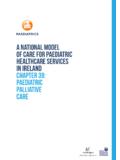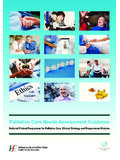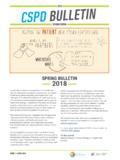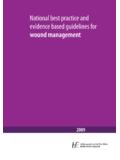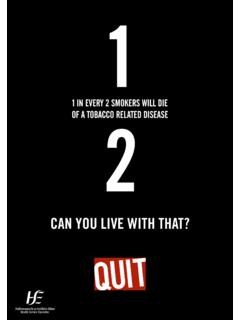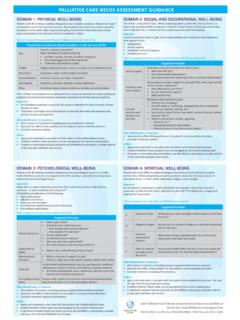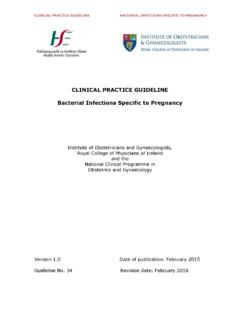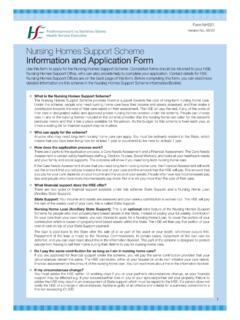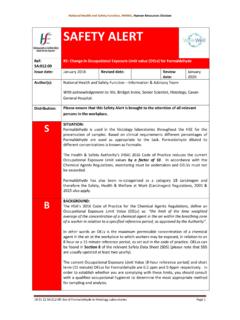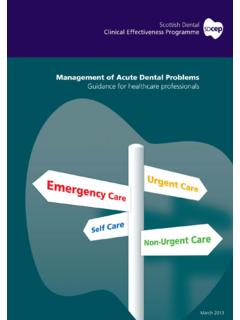Transcription of A National Model of Care for Paediatric Healthcare ...
1 A National Modelof care for PaediatricHealthcare Servicesin IrelandChapter 21:PaediatricDentistryClinical Strategy and Programmes DivisionTable of Introduction Current Service Provision 2 Access 2 Staffing 3 services and Activity Proposed Model of care 4 Primary care 5 Secondary care 5 Tertiary care 6 Prevention and Self-Management Requirements for Successful Implementation of Model of care 7 Interdependencies 7 care Pathways and Clinical Guidelines 8 Education and Training Programme Metrics and Evaluation Governance Key Recommendations Abbreviations and Acronyms References Appendices 121national Clinical Programme for Paediatrics and neonatology.
2 A National Model of care for Paediatric Healthcare services in InTroduCTIonOral health and dental care is medically necessary to prevent, manage and eliminate oro-facial disease, infection and pain; to restore the form and function of the dentition; and to correct facial disfigurement or dysfunction. Oral disease damages a child s self-esteem, school performance, and ability to eat, sleep and thrive (US Surgeon General Report on Oral Health, 2000). There is a growing body of evidence linking periodontal (gum) disease to major systemic conditions such as diabetes, respiratory and cardiovascular diseases, low birth weight and rheumatoid arthritis. Dental caries is the most common chronic disease of childhood in ireland (O Mullane et al.)
3 , 2002; Whelton et al., 2006).As an internationally recognised specialty of dentistry, Paediatric dentistry (PD) is the practice and teaching of, and research into, the comprehensive and therapeutic oral health care of children from birth to adolescence, including care of children with special health care needs such as a physical, developmental, mental, sensory, behavioural, cognitive, or emotional impairment or limiting condition that requires medical management, health care intervention, and/or use of specialised services or programs. (AAPD, 2015). Most children will have simple dental needs and their care can be provided by a general dentist in the primary care setting. PD provides care beyond the scope of a general dentist. A Paediatric dentist is best placed to coordinate or provide oral health care services for children with additional needs that require specialised knowledge arising from additional training, as well as increased awareness, adaptation and accommodation beyond that which is considered routine.
4 In Europe, in order to become a Paediatric dentist, a dentist must successfully complete at least three years of additional training in an advanced education programme. In ireland , as in most European Union (EU) countries, the only officially recognised specialties of dentistry are Oral Surgery and Orthodontics. The Dental Council supports the recognition of additional specialties, including PD, but the current Dental Act requires the approval of the Minister for Health to do so. CurrenT servICe ProvIsIonFor the majority of children, the current service pathway consists of examination, followed by preventive care and advice for families and primary care for defects noted during screening. Defects include caries, traumatic dental injury, periodontal diseases or orthodontic problems.
5 AccessChildren aged 15 and under in ireland are eligible for state funded public dental services , provided by salaried dental staff employed through the Health Service Executive (HSE). Access to this service is resource dependent and varies throughout the country but children in certain classes, largely in primary school, are targeted for: Assessment Application of preventive measures Oral health education Fluoride mouth rinsing Fissure sealing of vulnerable molar (back) teethAn emergency service is available to those not in the target classes, and this walk-in urgent care is the starting point on the care pathway for some Clinical Programme for Paediatrics and neonatology:a National Model of care for Paediatric Healthcare services in IrelandThe need for dental treatment for children, both met and unmet, is overwhelming.
6 The last comprehensive survey of children s oral health was in 2002, when 30% of 5 year old residents of fluoridated communities in the Republic of ireland had one or more decayed, missing or filled teeth. In the non-fluoridated communities of the Republic and Northern ireland , 47% of this age group had dental decay. Two thirds of 15 year olds were found to have decay in their permanent teeth. In general, the levels of caries are significantly higher among the less well off, and dental caries also tends to be polarised so that approximately 20% of the population carries 80% of the disease. In addition to dental disease, traumatic injuries account for a significant proportion of dental need. It is estimated that, for every 1,000 fifteen year olds, 220 have at least one permanent front tooth damaged accidentally.
7 This figure has not changed since 1984, and a large proportion of traumatised teeth remain untreated (O Mullane et al., 2002). There are also many other conditions affecting the oral cavity that require management by the dental service such as inherited conditions of dentition. staffingWhile an office-hours urgent care service is available for all eligible children, access to state funded dental examinations and treatment generally commences in primary school and is limited to specific target classes. There is no other state-funded or state-subsidised dental service for children. There are a small number of senior dental surgeon positions in the HSE that are filled by dentists trained in PD, but formal care pathways are needed to improve access to specialist services nationally.
8 Outside of that which is provided for children in the catchment areas of the children s hospitals, and Dublin and Cork University Dental Schools, publicly funded secondary care children s dental services need to be developed and extended. Much of the dentistry provided for children in ireland is funded privately by parents, with a low level of private insurance specialist orthodontic treatment is available through the HSE, with eligibility based on the severity of the problem according to nationally agreed standardised criteria. This Model of care for a dental subspecialty could serve as a template for other dental services for children in ireland . There are approximately 24 Paediatric dentists practicing currently in ireland (full- and part-time).
9 Eight of these are primarily hospital- and university-based, two are employed at non-specialist dental surgeon grades in the HSE, while the remainder are in fee per service private practice settings largely without health insurance cover. Based on the 2011 census population data of 1,036,817 children aged 15 years and under, this equates to one Paediatric dentist per 43,000 , tertiary and quaternary care PD services are currently provided at Our Lady s Children s Hospital Crumlin (Crumlin), National Children s Hospital Tallaght (Tallaght), Children s University Hospital Temple Street (Temple Street), Dublin Dental University Hospital, Cork University Hospital and University College Cork Dental School and Hospital. Much of the workload involves providing dental care for children managed at the individual hospitals as part of their National programmes, in haematology, oncology, cardiology, respiratory, inherited metabolic disease, and cleft, craniofacial and orthodontic services .
10 The dental services at Tallaght and Temple Street hospitals are grossly under-resourced, currently operating on a part-time basis with access limited to internal referrals only. There is no consultant led Paediatric dental service in the nineteen other Paediatric centres nationally. Equitable access to dental care for children nationwide is needed services and activityAccording to Hospital Inpatient Enquiry (HIPE) data from 2012, there were a total of 8,601 procedures recorded for the under 15 age group. Minor surgical procedures, such as extractions and/or restorative care under local anaesthesia, do not trigger an admission to hospital and as such are not recorded on HIPE. This figure of 8,601 is 3 National Clinical Programme for Paediatrics and Neonatology:A National Model of care for Paediatric Healthcare services in Irelandsecond only to surgeries commonly attributable to Ear, Nose and Throat (ENT) surgery, ear, mastoid process, nose, mouth and pharynx (approximately 12,000 procedures).
